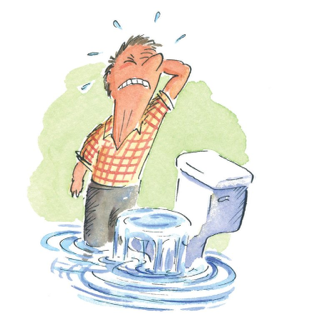
Toilet Leaks
Toilet Leaks
One of the most common sources of plumbing leaks is from toilets. With 1.5 gallons of water used with every flush, it is easy to see why it is important to keep a close watch for impending toilet leaks. Regularly inspect behind and around toilets for dampness, puddles, mold and mildew. The longer you wait to deal with leaks from toilets, the greater the risk of allowing contaminated water waste to seep into your bathroom. Below you will find a list of the most common toilet leaks you may encounter:
- Commode Connections: If a puddle is discovered at the base of the toilet check to see if the nuts that attach the toilet to the floor are attached properly or corroded. They may need tightening or replacing.
- Water Supply lines: Water around the toilet base could be from a leaky supply line. The water pipe that runs from the back of the toilet to the wall might have come loose and needs to be fixed or it could be corroded and has developed a pinhole leak. It isn’t always easy to tell where the leak is coming from, so repairing the leak can be about eliminating problem areas on the toilet supply line such as bad washers, the fittings, or the line itself.
- Supply Tank Overflow: May be from a bad flapper or bad fill valve. If the flapper doesn’t seal properly, water can leak from the tank drain. A fill valve that doesn’t shut off completely when the toilet tank is refilled will continue to send water into the tank. If it drips or makes a fizzing sound the fill valve is bad and should be replaced.
- Toilet bowl overflow: Can be due to a clogged drain. Turn off the toilet’s water supply using the valve on the wall behind the toilet. You can then use a plunger or a drain snake to clear out the offending matter.
- Wax ring seal failure: The wax ring is mounted on the bottom of your toilet to the flange, which is a pipe fitting that connects a toilet to the home’s drainage system. Its important job is to create an airtight seal to prevent water and sewer gas from escaping from the toilet drain pipe. The wax ring should seal so no waste material can get out from around the drain when the toilet is seated on it. When the wax ring goes bad, it needs to be replaced right away.
Recognizing the following signs of wax ring failure will help to avoid major plumbing repairs:
- Toilet Unstable
- Water around the toilet base.
- Bad odors coming from toilet: This is a serious situation that will need prompt action. It may be sewer gas that has made it past the wax ring. Sewer gases are harmful to humans and dangerous around an open flame. Be aware that sometimes the bad smell exists even when no water is around the base.
- Ceiling or Floor Damage: Even if there is no water present it could still mean a lot of damage is in the making. Is there is a bathroom directly above the damage? Severe damage could lead to a toilet falling through the floor, or in that case, also the ceiling. We may have seen this comically in movies but sadly, this really does happen.
Call Water Extraction Experts: The Experts in Care!
Quickly responding to water and mold damage can save you money and much grief. The trained and certified team at Water Extraction Experts will quickly come to your aid with the latest in water extraction technology making your house safe and clean again.
Water Extraction Experts specializes in water damage restoration, sewage cleanup, mold removal and flood damage cleanup.
EMERGENCY 24/7 WATER DAMAGE
CALL: 505-808-2080
The Experts That Care
